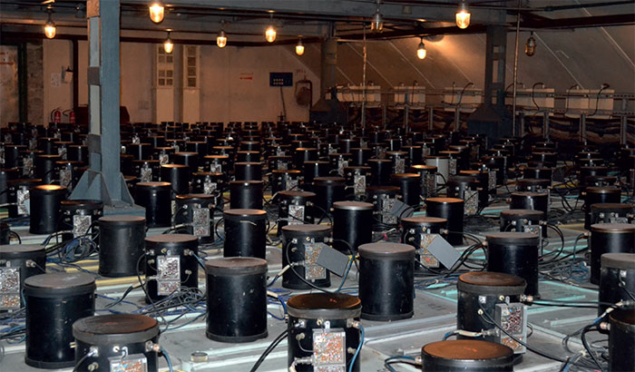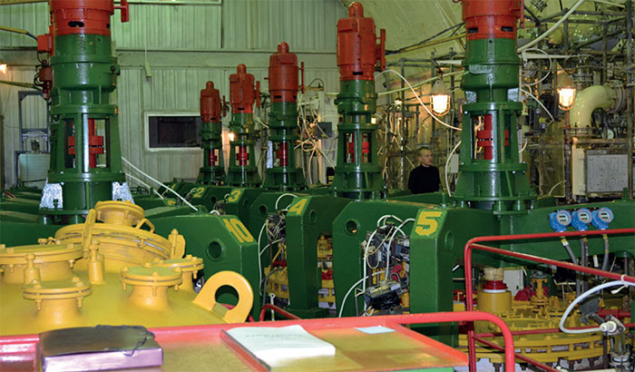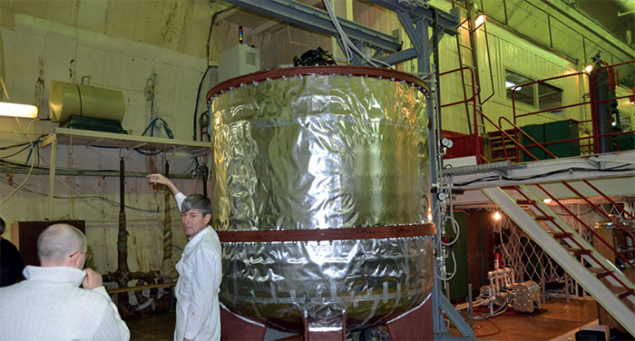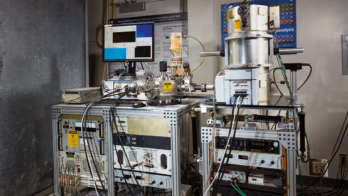The Baksan Neutrino Observatory celebrates 50 years of success.

Image credit: V Petkov.
On 29 June 1967, the Soviet government issued a document that gave the go-ahead to build a brand new underground facility for neutrino physics in the Baksan valley in the mountainous region of the Northern Caucasus. Construction work began straight away on the tunnels under the 4000 m-high peak of Mount Andyrchi that would contain the experimental halls, and 10 years later, the laboratory’s first neutrino telescope started operation. Today, a varied experimental programme continues at the Baksan Neutrino Observatory, which is operated by the Institute for Nuclear Research (INR) of the Russian Academy of Sciences (RAS). And there is the promise of more to come.

Image credit: Y Gavrilyuk.
The detailed proposal for the Baksan Neutrino Observatory was put together by “the father of neutrino astronomy”, Moisei Markov, and his younger colleagues, Alexander Chudakov, George Zatsepin and Alexander Pomansky, together with many others. The decision to construct a dedicated underground facility rather than use an existing mine – something that had never been done before – gave the scientists the freedom to choose the location and the structure of their future laboratory to maximise its scientific output. Their proposal to house it in an almost horizontal tunnel under a steep mountain decreased the construction costs by a factor of six with respect to a mine, while maintaining higher safety standards. They selected Andyrchi – one of a series of peaks dominated by Europe’s highest mountain, Mount Elbrus (5642 m) – from many potential sites. The entrance to the laboratory tunnel is located in the valley below the peaks, which is well known to mountaineers, hikers and skiers, at an altitude of 1700 m. A small village called Neutrino was built to accommodate scientists and engineers working for the observatory, with office and laboratory buildings, some surface installations, living quarters and related infrastructure.
The basic idea of underground neutrino detection is to use soil and rock to shield the installations from muons produced in cosmic-ray interactions with the atmosphere – the main background for neutrino detection. The underground complex at Baksan contains two interconnected tunnels (having two is a safety requirement) with laboratory halls situated at various distances along the tunnels, corresponding to different shielding conditions below the mountain. At the end of the 4 km-long tunnels, the flux of the muons is suppressed by almost 10 million times with respect to the surface.
Experiments past
The first experiment to start at Baksan, back in 1973, was not however underground. The Carpet air-shower experiment completely covered an area of around 200 m2 with 400 liquid-scintillator detectors, identical to those of the first neutrino telescope “BUST” (see below). Its key task was a detailed study of the central part of air showers produced by cosmic particles in the atmosphere. One of its first results, based on the interpretation of shower sub-cores as imprints of jets with high transverse-momenta – born in the primary interactions of the cosmic rays – was on the production cross-section of these jets for leading-particle energies up to 500 GeV. This result was published earlier than the corresponding measurement at CERN’s Super Proton Synchrotron and confirmed predictions of quantum chromodynamics. Carpet’s discoveries of astrophysical importance included a puzzling giant flare in the Crab Nebula in 1989.

Image credits: P Kolomeytsev.
The Baksan Underground Scintillator Telescope (BUST) started operation in 1977. A multipurpose detector, it is located in an artificial cavern with a volume of 12,000 m3 located 550 m from the tunnel entrance. The telescope is a four-level underground building 11.1 m high with a base area of 280 m2. The building, made of low-radioactivity concrete, houses 3180 detectors containing 330 tonnes of liquid scintillator. Sensitive to cosmic neutrinos with energies of dozens of MeV, the detector is well suited to the search for supernova neutrinos, and on 23 February 1987 it was one of four detectors in the world that registered the renowned neutrino signal from the supernova 1987A in the Large Magellanic Cloud. The results obtained with the telescope have been used for cosmic-ray studies, searches for exotic particles (notably, magnetic monopoles) and neutrino bursts.
Neutrinos with lower energies were the target of the Gallium–Germanium Neutrino Telescope, a pioneering device to search for solar neutrinos in the SAGE (Soviet–American Gallium Experiment) project. The first experiments to detect neutrinos from the Sun – Homestake in the US and Kamiokande II in Japan – registered neutrinos with energies of a few MeV, which are mainly produced in the decay of boron-8 and constitute less than 1% of the total solar-neutrino flux. These Nobel-prize-winning experiments revealed the solar-neutrino deficit, subsequently interpreted in terms of neutrino oscillations, the only firm laboratory indication so far for the incompleteness of the Standard Model of particle physics. However, to assess the problem fully, it was necessary to find out what happens with the bulk (86% of the total flux) of the solar neutrinos, which come from proton–proton (pp) fusion reactions and have energies below about 0.4 MeV.
In 1965, Vadim Kuzmin proposed using the reaction 71Ga + νe → 71Ge + e− to detect the low-energy solar neutrinos. This idea was implemented in two experiments: GALLEX in the Gran Sasso National Laboratory and SAGE at Baksan. SAGE, which has been in operation since 1986 and is led by Vladimir Gavrin, is located 3.5 km from the tunnel entrance, where the cosmic-ray muon flux is suppressed by a factor of several million. About 50 tonnes of liquid gallium are used as a target; amazingly, a special factory was built to produce this amount of gallium, which exceeded the total consumed by the Soviet Union at the time. A unique chemical technology was developed to allow about 15 germanium atoms to be extracted from the 50 tonnes of gallium every month.

Image credit: S Demidov.
SAGE and GALLEX were the first experiments to detect solar pp neutrinos and to confirm the solar-neutrino deficit for the bulk of the flux. Combined with results from other experiments to subtract sub-leading contributions from other channels, SAGE found the solar pp neutrino flux to be 6.0±0.8 × 1010 cm–2 s–1. This agrees nicely with the solar-model prediction (taking into account neutrino oscillations) of 5.98±0.04 × 1010 cm–2 s–1 and the result has been confirmed by the 2014 measurement by Borexino, using a different method, which gives 6.6±0.7 × 1010 cm–2 s–1.
The unique underground conditions at Baksan also allowed the creation of several ultra-low-background laboratories where, in addition to the natural shielding, materials with extremely low radioactivity were used in construction. There are three shielded chambers at different depths where rare nuclear processes have been searched for and a number of low-background experiments performed, including a precise measurement of the isotopic composition of the lunar soil delivered by the Luna-16, Luna-20 and Luna-24 spacecraft.
Current experiments
Now 50, the Baksan Neutrino Observatory continues to probe the neutrino frontier. The scintillator telescope is still monitoring the universe for neutrino bursts, its almost 40 year exposure time setting stringent constraints on the rate of core-collapse supernova in the Milky Way. The non-observation of neutrinos associated with the gravitational-wave event of 15 September 2015, detected by the LIGO Observatory, puts a unique constraint on the associated flux of neutrinos with energies of 1–100 GeV, complementary to constraints from larger experiments at different energies.

Image credit: S Demidov.
Calibration of the gallium solar-neutrino experiments, SAGE and GALLEX, with artificial neutrino sources has revealed the so-called gallium anomaly, which can be understood in terms of a new, sterile-neutrino state. A new experiment called the Baksan Experiment on Sterile Transitions (BEST), has been instigated to check the anomaly and thus test the sterile-neutrino hypothesis. This will be based on a 51Cr artificial neutrino source with an intensity of around 100 PBq, placed in the centre of a spherical gallium target of two concentric zones with equal neutrino mean-free-paths; any significant difference in the rate of neutrino capture in the inner and outer zones would indicate the existence of a sterile neutrino. CrSOX, a similar experiment with the Borexino detector at Gran Sasso, might become competitive with BEST but only in its full-scale configuration with the 400 PBq neutrino source. Reactor experiments would provide complementary information about a sterile antineutrino.
BEST is now fully constructed and is awaiting the artificial neutrino source. Meanwhile, ultra-pure gallium is still used in the SAGE experiment, confirming the stability of the solar-neutrino flux over decades: fortunately, the Sun is not about to change its power output.
Numerous experiments are being carried out in the low-background laboratory, thanks to a new experimental hall – Low Background Lab 3 on the figure above – located 3.67 km from the tunnel entrance (providing shielding equivalent of 4900 m of water). One of them searches for solar axions via their resonant reconversion on 83Kr, and this experiment has already resulted in the world’s best constraint on certain couplings of the hadronic axion.
Among the surface-based experiments, the Carpet air-shower array is undergoing the most intense development. Equipped with a brand new muon detector with an area of 410 m2, this old cosmic-ray installation is starting a new life as a sophisticated sub-PeV gamma-ray telescope. A world-best sensitivity to the diffuse gamma-ray flux above 100 TeV, which could be achieved by the end of 2017, would be sufficient to decide between the galactic and extragalactic origin of the high-energy astrophysical neutrinos detected by the IceCube neutrino observatory at the South Pole.

Image credit: S Demidov.
Other experiments are also ready to produce interesting results. The Andyrchi air-shower array located on the slope of the mountain above BUST works in coincidence with the telescope, which serves as a muon detector with a 120 GeV threshold. A small gravitational-wave detector, OGRAN, capable of registering a galactic supernova, makes Baksan a true multi-messenger observatory. In addition, important interdisciplinary studies are taking place at the border with geophysics. They include not only deep-underground precise monitoring of seismic and magnetic parameters close to the sleeping volcano Elbrus, but also, for example, studies of atmospheric electricity and its relation to the cosmic-ray muon flux.
Future prospects
Looking ahead, the Baksan Neutrino Observatory could host new breakthrough experiments. The many planned projects include a further upgrade of the Carpet array with the increase in both the surface-array and muon-detector areas for the purposes of sub-PeV gamma-ray astronomy; a new resonant-reconversion solar axion experiment with a sensitivity an order of magnitude better than the present one; and a circular laser interferometer – or Sagnac gyroscope – for geophysics and fundamental-physics measurements.
However, the main project for the observatory is the Baksan Large-Volume Scintillator Detector (BLVSD, although the name of the experiment is yet to be fixed). This detector, currently at the R&D stage, should contain 10–20 kilotonnes of ultra-pure liquid scintillator and could be located at the end of the observatory tunnel. There, unused artificial caverns exist in which a Cl–Ar solar-neutrino experiment was originally planned, but was replaced by the SAGE Ga–Ge detector in a different cave. This large-volume detector should be able to detect not only neutrinos from a galactic core-collapse supernova, but also the composite neutrino background of numerous distant explosions, thus making it possible to study supernova neutrinos in the unlucky, but probable, case that no galactic explosion happens in the coming decades. In the opposite case, the large neutrino statistics from a nearby explosion would open up possibilities for a detailed study.

Image credit: S Demidov.
For solar neutrinos, BLVSD would be capable of measuring the neutrino flux from the carbon–nitrogen–oxygen (CNO) fusion cycle in the Sun with a precision sufficient to discriminate between various solar models and therefore solve experimentally the present-day contradiction between results from helioseismology and those from chemical-composition studies of the solar surface. A primary target for BLVSD would be the study of geoneutrinos, which are produced in nuclear decays in the Earth’s interior. Clearly, the detector could also be used for a precise study of neutrino oscillations, in particular with a dedicated long-distance accelerator beam.
BLVSD would join a global network of large-scale neutrino detectors, if created. Such joint operation would open possibilities to solve many interesting problems. It would allow, for instance, the inclusion of effects of the inhomogeneous structure of the Earth’s crust in geoneutrino studies, or the determination of the direction of a supernova that is obscured and visible only in neutrinos. The unique conditions at the Baksan observatory would also make the solo operation of BLVSD efficient. Not only do the existing infrastructure and experience allow for ultra-low-background experiments, but the geographical position in the Northern Caucasus guarantees a large distance from nuclear reactors. For geoneutrinos, estimates of the ratio of the signal counting-rate to the background from artificial reactors give a value around 5 for Baksan, compared to around 1.1 for Borexino and around 0.15 for KamLand. It is the low background that would allow a precise measurement of the solar CNO flux, which is barely possible in any of the currently operating experiments.
The large-scale BLVSD project is still in its infancy, and numerous efforts in R&D, fundraising and construction are still to be made. The Baksan Neutrino Observatory is fully open for worldwide collaboration and co-operation, both in this and in other scientific projects. Happy birthday, Baksan.





